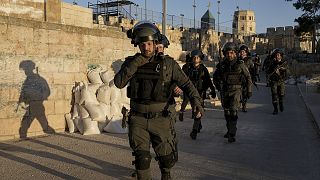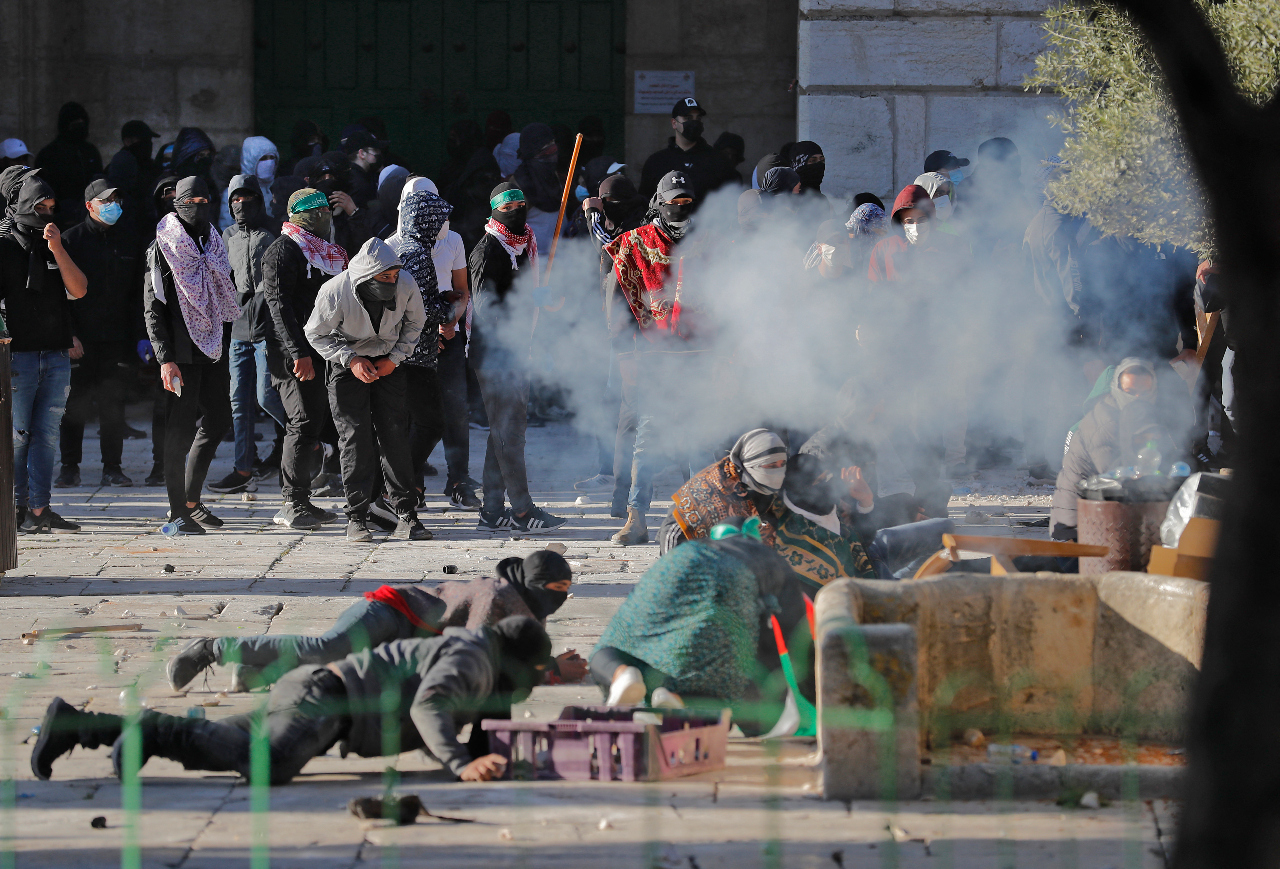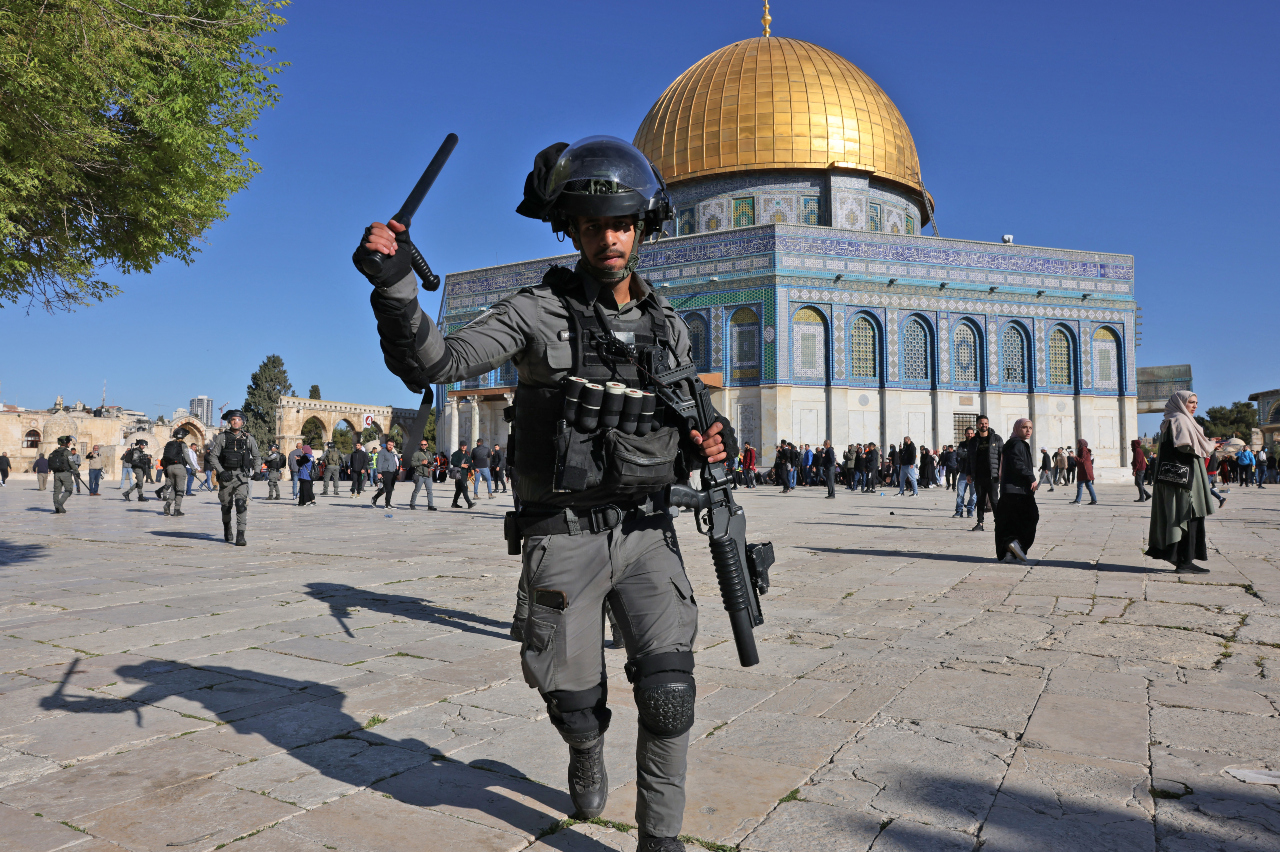April 15, 2022
THE ASSOCIATED PRESS

A group of people thought to be migrants are brought in to Dover, Kent, by the RNLI, following a small boat incident in the Channel, Thursday April 14, 2022.
Gareth Fuller/AP
LONDON — Britain announced a deal with Rwanda on Thursday to send some asylum-seekers thousands of miles to the East African country — a plan it said would stop people-smugglers sending desperate migrants on treacherous journeys across the English Channel.
U.K. opposition politicians and refugee groups condemned the move as inhumane, unworkable and a waste of public money, and the United Nations said it raised "a number of human rights concerns."
The plan would see some people who arrive in Britain as stowaways on trucks or in small boats picked up by the U.K. government and flown 4,000 miles (6,400 kilometers) to Rwanda, apparently for good.
LONDON — Britain announced a deal with Rwanda on Thursday to send some asylum-seekers thousands of miles to the East African country — a plan it said would stop people-smugglers sending desperate migrants on treacherous journeys across the English Channel.
U.K. opposition politicians and refugee groups condemned the move as inhumane, unworkable and a waste of public money, and the United Nations said it raised "a number of human rights concerns."
The plan would see some people who arrive in Britain as stowaways on trucks or in small boats picked up by the U.K. government and flown 4,000 miles (6,400 kilometers) to Rwanda, apparently for good.

EUROPE
At least 31 people are dead after a migrant boat capsizes in the English Channel
Critics accused Prime Minister Boris Johnson of using the issue to distract attention from a scandal over government gatherings that breached pandemic lockdown rules. Johnson is resisting calls to resign after being fined by police this week over the parties.
Migrants have long used northern France as a launching point to reach Britain, either by hiding on trucks or ferries, or — increasingly since the coronavirus pandemic shut down other routes in 2020 — in small boats organized by smugglers. More than 28,000 people entered the U.K. in boats last year, up from 8,500 in 2020. Dozens have died, including 27 people in November when a single boat capsized.
On Thursday, dozens of men, women and children were picked up by British lifeboats and brought ashore at the Channel port of Dover as Johnson, speaking just a few miles away, outlined the plan.
"Anyone entering the U.K. illegally ... may now be relocated to Rwanda," Johnson said in a speech to troops and coast guard members at an airport near Dover. Action, he said, was needed to stop "vile people smugglers (who) are abusing the vulnerable and turning the Channel into a watery graveyard."
The Rwandan government said the agreement would initially last for five years, and Britain had paid 120 million pounds ($158 million) up front to pay for housing and integrating the migrants.
Rwandan Foreign Affairs Minister Vincent Biruta said the agreement "is about ensuring that people are protected, respected, and empowered to further their own ambitions and settle permanently in Rwanda if they choose."
He said his country is already home to more than 130,000 refugees from countries including Burundi, Congo, Libya and Pakistan.
Johnson denied the plan was "lacking in compassion" but acknowledged it would inevitably face legal challenges and would not take effect immediately.
Rwanda is the most densely populated nation in Africa, and competition for land and resources there fueled decades of ethnic and political tensions that culminated in the 1994 genocide in which more than 800,000 ethnic Tutsis, and Hutus who tried to protect them, were killed.
EUROPE
U.K. Officials Apologize After Lives Of Caribbean Immigrants Thrown Into Disarray
Johnson insisted that Rwanda had "totally transformed" in the last two decades. But human rights groups have repeatedly criticized President Paul Kagame's current government as repressive.
Lewis Mudge, Central Africa director at Human Rights Watch, said the claim Rwanda was a safe country "is not grounded in reality."
"Arbitrary detention, ill-treatment, and torture in official and unofficial detention facilities is commonplace, and fair trial standards are flouted in many cases," Mudge said.
Britain says relocation decisions will not be based on migrants' country of origin but on whether they used "illegal or dangerous routes" to reach the U.K. from a safe country such as France. Not all such arrivals will be considered suitable to be sent to Rwanda; it was unclear what the criteria for making the decisions would be, though the British government said children would not be sent to the African country.
The United Nations' human rights office said it had raised its "concerns directly with the U.K. authorities."
A spokeswoman for the office said the U.K. was "shifting ... its responsibilities and obligations under international human rights and refugee law onto a country which is already taking great asylum responsibilities."
Previous policies of sending refugee applicants abroad have been highly controversial.
In 2013, Australia began sending asylum-seekers attempting to reach the country by boat to Papua New Guinea and the tiny atoll of Nauru, vowing that none would be allowed to settle in Australia. The policy all but ended the people-smuggling ocean route from Southeast Asia, but was widely criticized as a cruel abrogation of Australia's international obligations.
Israel sent several thousand people to Rwanda and Uganda under a contentious and secretive "voluntary" scheme between 2014 and 2017. Few are believed to have remained there, with many trying to reach Europe.
Steve Valdez-Symonds, refugee director at Amnesty International U.K., said the British government's "shockingly ill-conceived idea will go far further in inflicting suffering while wasting huge amounts of public money."
The chief executive of the U.K.-based Refugee Council, Enver Solomon, called it "dangerous, cruel and inhumane."
Rwandan opposition figure Victoire Ingabire told the AP that her government's decision to take in migrants was questionable, given that the country is also a source of refugees.
The British and French governments have worked for years to stop the cross-Channel journeys, without much success, often swapping accusations about who is to blame for the failure.
Britain's Conservative government has floated myriad proposals, not all of them workable, including building a wave machine in the Channel to drive boats back. Johnson said Thursday that the Royal Navy would take charge of responding to small-boat crossings, but that the idea of pushing vessels back towards France had been rejected as too dangerous.
Several earlier proposed locations for the U.K. to send migrants — including the remote Ascension Island, Albania and Gibraltar — were rejected, at times angrily, by the nations in question.
The Rwanda plan faces hurdles both in Britain's Parliament and in the courts. Johnson's Conservative government has introduced a tough new immigration bill that would make it more difficult for people who enter the country by unauthorized routes to claim asylum and would allow asylum-seekers to be screened abroad. It has not yet been approved by Parliament, with the House of Lords seeking to dilute some of its most draconian provisions.
Labour Party lawmaker Lucy Powell said the Rwanda plan might please some Conservative supporters and grab headlines, but was "unworkable, expensive and unethical."
"I think this is less about dealing with small boats and more about dealing with the prime minister's own sinking boat," Powell told the BBC.
UK says Rwanda flights to start in weeks; critics slam plan
By JILL LAWLESS

1 of 4
“Such arrangements simply shift asylum responsibilities, evade international obligations, and are contrary to the letter and spirit of the Refugee Convention,” said the agency’s Assistant High Commissioner for Protection, Gillian Triggs. “People fleeing war, conflict and persecution deserve compassion and empathy. They should not be traded like commodities and transferred abroad for processing.”
Previous schemes to ”offshore” asylum-seekers have been highly controversial.
In 2013, Australia began sending asylum-seekers attempting to reach the country by boat to Papua New Guinea and the tiny atoll of Nauru, vowing that none would be allowed to settle in Australia. The policy all but ended the people-smuggling ocean route from Southeast Asia, but was widely criticized as a cruel abrogation of Australia’s international obligations.
Critics of the U.K.-Rwanda plan say it is certain to face legal challenges. The prime minister acknowledged Thursday it would likely be challenged in court by what he called “politically motivated lawyers” out to ”frustrate the government.”
The Law Society of England and Wales, which represents solicitors, chastised the government for offering “misleading suggestions that legal challenges are politically motivated.”
“Legal challenges establish if the government is abiding by its own laws,” said society President I. Stephanie Boyce. “If the government wishes to avoid losing court cases, it should act within the law of the land.”
___
Follow AP’s coverage of migration issues at https://apnews.com/hub/migration
By JILL LAWLESS

1 of 4
A group of people thought to be migrants are brought in to Dover, Kent, England, by the RNLI, following a small boat incident in the Channel, Thursday April 14, 2022. Britain's Conservative government has struck a deal with Rwanda to send some asylum-seekers thousands of miles away to the East African country. Opposition politicians and refugee groups are condemning the plan as unworkable, inhumane and a waste of public money. (Gareth Fuller/PA via AP)
LONDON (AP) — The British government said Friday that it plans to start putting asylum-seekers on one-way flights to Rwanda within weeks, as it defended a deal that has outraged refugee groups and humanitarian organizations.
Britain and Rwanda announced Thursday that they had struck an agreement that will see some people arriving in the U.K. as stowaways on trucks or in small boats sent 4,000 miles (6,400 kilometers) to the East African country, where their asylum claims will be processed and, if successful, they will stay.
The British government says the plan will discourage people from making dangerous attempts to cross the English Channel, and put people-smuggling gangs out of business.
But critics of the Conservative government said legal and political hurdles mean the flights may never happen. They accused Prime Minister Boris Johnson of using the headline-grabbing policy to distract attention from his political troubles. Johnson is resisting calls to resign after being fined by police this week for attending a party in his office in 2020 that broke coronavirus lockdown rules.
Conservative lawmaker Andrew Griffith, a senior Johnson adviser, said the flights to Rwanda could start “in weeks or a small number of months.”
Migration Minister Tom Pursglove said the drastic plan was needed to deter people trying to reach Britain in dinghies and other boats from northern France. More than 28,000 migrants entered the U.K. across the Channel last year, up from 8,500 in 2020. Dozens have died, including 27 people in November when a single boat capsized.
“Nobody should be coming in a small boat to come to the United Kingdom,” Pursglove told Sky News. “We quite rightly have a rich and proud history in this country of providing sanctuary for thousands of people over the years. …. But what we can’t have, and we can’t accept, is people putting their lives in the hands of these evil criminal gangs, and that’s why we think it is important that we take these steps.”
The deal — for which the U.K. has paid Rwanda 120 million pounds ($158 million) upfront — leaves many questions unanswered, including its final cost and how participants will be chosen. The U.K. says children, and families with children, will not be sent to Rwanda.
Refugee and human rights groups called the plan inhumane, unworkable and a waste of taxpayers’ money. The United Nations’ Refugee Agency urged Britain and Rwanda to reconsider.
LONDON (AP) — The British government said Friday that it plans to start putting asylum-seekers on one-way flights to Rwanda within weeks, as it defended a deal that has outraged refugee groups and humanitarian organizations.
Britain and Rwanda announced Thursday that they had struck an agreement that will see some people arriving in the U.K. as stowaways on trucks or in small boats sent 4,000 miles (6,400 kilometers) to the East African country, where their asylum claims will be processed and, if successful, they will stay.
The British government says the plan will discourage people from making dangerous attempts to cross the English Channel, and put people-smuggling gangs out of business.
But critics of the Conservative government said legal and political hurdles mean the flights may never happen. They accused Prime Minister Boris Johnson of using the headline-grabbing policy to distract attention from his political troubles. Johnson is resisting calls to resign after being fined by police this week for attending a party in his office in 2020 that broke coronavirus lockdown rules.
Conservative lawmaker Andrew Griffith, a senior Johnson adviser, said the flights to Rwanda could start “in weeks or a small number of months.”
Migration Minister Tom Pursglove said the drastic plan was needed to deter people trying to reach Britain in dinghies and other boats from northern France. More than 28,000 migrants entered the U.K. across the Channel last year, up from 8,500 in 2020. Dozens have died, including 27 people in November when a single boat capsized.
“Nobody should be coming in a small boat to come to the United Kingdom,” Pursglove told Sky News. “We quite rightly have a rich and proud history in this country of providing sanctuary for thousands of people over the years. …. But what we can’t have, and we can’t accept, is people putting their lives in the hands of these evil criminal gangs, and that’s why we think it is important that we take these steps.”
The deal — for which the U.K. has paid Rwanda 120 million pounds ($158 million) upfront — leaves many questions unanswered, including its final cost and how participants will be chosen. The U.K. says children, and families with children, will not be sent to Rwanda.
Refugee and human rights groups called the plan inhumane, unworkable and a waste of taxpayers’ money. The United Nations’ Refugee Agency urged Britain and Rwanda to reconsider.
“Such arrangements simply shift asylum responsibilities, evade international obligations, and are contrary to the letter and spirit of the Refugee Convention,” said the agency’s Assistant High Commissioner for Protection, Gillian Triggs. “People fleeing war, conflict and persecution deserve compassion and empathy. They should not be traded like commodities and transferred abroad for processing.”
Previous schemes to ”offshore” asylum-seekers have been highly controversial.
In 2013, Australia began sending asylum-seekers attempting to reach the country by boat to Papua New Guinea and the tiny atoll of Nauru, vowing that none would be allowed to settle in Australia. The policy all but ended the people-smuggling ocean route from Southeast Asia, but was widely criticized as a cruel abrogation of Australia’s international obligations.
Critics of the U.K.-Rwanda plan say it is certain to face legal challenges. The prime minister acknowledged Thursday it would likely be challenged in court by what he called “politically motivated lawyers” out to ”frustrate the government.”
The Law Society of England and Wales, which represents solicitors, chastised the government for offering “misleading suggestions that legal challenges are politically motivated.”
“Legal challenges establish if the government is abiding by its own laws,” said society President I. Stephanie Boyce. “If the government wishes to avoid losing court cases, it should act within the law of the land.”
___
Follow AP’s coverage of migration issues at https://apnews.com/hub/migration

























